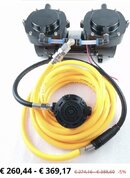Their web site explains it clearly.
BLU3 | Ultra-portable dive systems — BLU3 Ultra-Portable Dive Systems
here their explanation:
The Smart Reg™
What allows Nemo to be so compact, energy-efficient, and responsive is our patent-pending Smart Reg™ – the first of its kind!
Here’s how it works: A silicone diaphragm inside the Smart Reg™ moves when the diver breathes. A waterproofed sensor measures the diaphragm movement – it then sends an electronic signal which triggers the compressor to pump air at exactly the time and speed that the diver is inhaling.
Nemo pumps only the exact pressure, volume, and flow rate that the diver needs at their particular depth which means it uses just a fraction of the energy of any other underwater breathing system. That’s why we can use smaller pumps, motors, and batteries – bringing you the most portable and affordable underwater breathing system ever!




